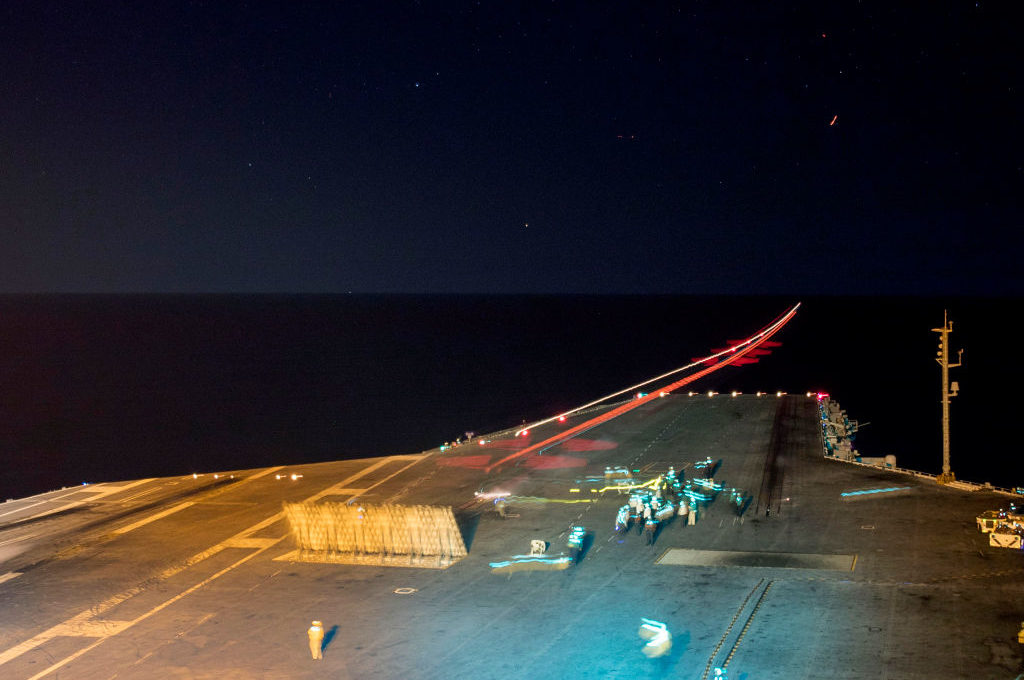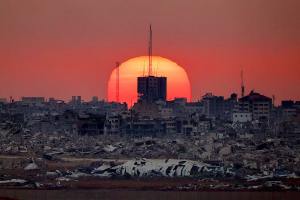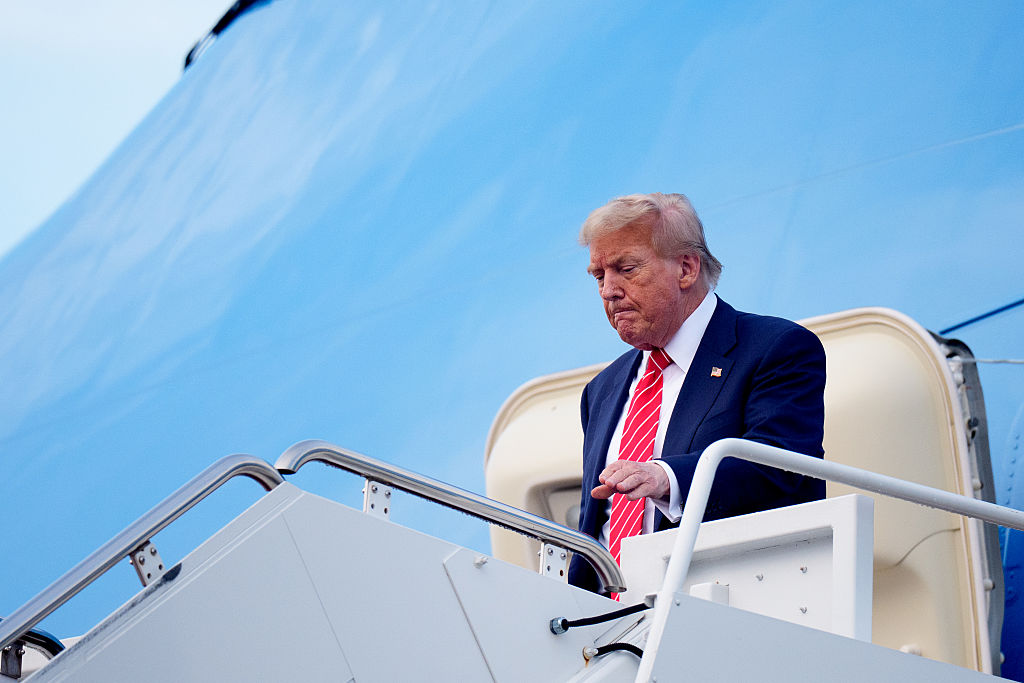Donald Trump says that America could ‘end’ Iran, and no doubt we could. The US could launch an air campaign that would destroy the Islamic Republic’s most important military assets. But it’s hard to see exactly how. With a diminishing number of useful allies, not to mention a military exhausted from 18 years of war on terror, America is not in the position it once was to exert great force in the Middle East.
Ever since the push to invade Iraq, the US has been shedding allies. We have become increasingly dependent for help on an unimpressive handful of wannabes. Turkey sat out the Iraq War: so did France, Germany and Canada, three of our most potent military supporters. Today’s ‘coalition of the willing’ in an action against Iran might look even less impressive.
There seems little doubt that the US could launch an air campaign that would destroy the Islamic Republic’s most important military assets – but it might have to rely on four fighter squadrons of F-18E Super Hornets (from Carrier Air Wing 7) aboard the USS Abraham Lincoln, perhaps 90 aircraft in all. That’s a lot of firepower, though not nearly the ‘unrelenting force’ promised by John Bolton.
The true ‘unrelenting force’ against Iran would probably come from bombers deployed in the Middle East. The problem is that the US has few aircraft deployed at the airbases of its most reliable regional allies, manifestly because no such airbases exist: Saudi Arabia showed the US military the door in April 2003 (at the end of Operation Iraqi Freedom), the UAE hosts a contingent of US air wings deploying surveillance aircraft (which are useful, but not unrelenting), Bahrain is home of the US Navy’s 5th Fleet (with an indeterminate but decidedly unrobust number of F-16s and F-18s), Kuwait allows the US to use its airfields for cargo operations, Jordan trains with the US military (but that’s about it), and the US military presence in Oman is negligible.
Nor could the US depend on the airpower wielded by its regional friends: Saudi Arabia’s air force is maintained by the US, the Emirati Air Force is impressive, but small – while the offensive air capabilities of Bahrain, Jordan, Kuwait and Oman (even if they would agree to join an attack, which is very much in doubt) are minimal, at best. That leaves Israel, Turkey – and Qatar.
US sales of fighter aircraft to Israel has made Israel the most potent force in the region, but its 10 (or so) active squadrons are hamstrung by their range. Israeli F-18s (and even its newest squadrons of the US-made F-35), can make it to targets in Iran, but can barely make it back. That means the IAF would be dependent on mid-flight refueling from American airborne tankers. Then too, bringing Israel into a fight against Iran would send America’s regional allies scampering for the exits, whether they welcome a war against Iran or not. Nor is it clear that the Israeli Air Force would help the US in such an attack – as its aircraft would be busy trying to find, and destroy, rocket sites manned by Iran’s ally Hezbollah in south Lebanon.
The US could mount air operations from Turkey, but the difficulty in doing that is that the base there, at Incirlik, has been closed to US offensive operations since 1975 – when the US enforced an arms embargo on Ankara in the wake of Turkey’s intervention in Cyprus. Since then, Incirlik has been used by the US as a stopover for US troops exiting Iraq and Afghanistan, and as home of the US 39th Air Base Wing, which mounts ‘Reaper Ops’ – MQ9 drones. As was the case with Operation Iraqi Freedom, US-Turkey relations are not only decidedly cool (the result of US support for the Kurdish-led Syrian Democratic Forces), it’s difficult to imagine a circumstance under which Ankara would agree to host US fighter-bombers in a war against Iran – which Turkey doesn’t want. Of course, the US could mount air attacks against Iran from its airfield in Diego Garcia, in the Indian Ocean, or from the US itself (as was done during recent military operations in the Middle East), but those kinds of operations strain US Air Force resources, which are already stretched. ‘We’ve been in the air since Desert Storm back in the Nineties,’ a senior Air Force officer told me several months ago, ‘and it’s starting to show.’
Which leaves Qatar. America operates the huge al-Udeid airbase in the tiny Gulf kingdom and the US (as reported elsewhere), has a ‘sweetheart deal’ on its use. But since the advent of John Bolton’s saber-rattling over Iran, senior US Air Force officers question whether the ‘sweetheart deal’ will hold during what could be a bloody and indeterminate war. Nor is it clear that US-Qatar agreement explicitly allows the US to attack Iran without Qatari permission. ‘The US-Qatari defense cooperation agreement is comprehensive and detailed, and I will not get into its particulars. It’s classified,’ the Congressional Research Service’s Kenneth Katzman, one of America’s foremost experts on the Middle East, told me. ‘But I think it would be safe to say that any kind of offensive actions the US undertakes from al-Udeid can only happen after a full consultation with the Qatari government.’
The former head of the US Central Command, retired Marine Gen. Anthony Zinni, agrees: ‘From my past experience, any offensive action taken by the US requires approval by the host nation,’ he says, ‘though I would think if it is an immediate response to a threat or attack, that might not hold.’ A retired senior US Air Force officer who served in the region, is less circumspect: ‘I think the Qataris would object if the US were to use al-Udeid for offensive operations, to punish Iran,’ he says. ‘I am not privy to the details of the US-Qatar agreement on the use of al-Udeid, but I wouldn’t be surprised if it lays out in some detail the kinds of operations it can be used for. The Qataris have a say in this and my bet is that when it comes to an attack on Iran, they would have the right to say “no.”’
None of this, of course, touches on what would happen if the US would mount an air attack on Iran – even if, somehow, the US could count on its regional military allies for help. ‘Iran is not Iraq,’ said retired Army Col. Lawrence Wilkerson in a recent interview, pointing out that the Iranian military is not only well trained, but well-armed. Any initial US air attack would focus on Iran’s air defenses, as well as on its major air assets. Senior US Air Force officers view that as a challenge, as the Iranians deploy the Russian-made S-300 air defense system. Russian weapons are not among the most sophisticated in the world, but that’s not true for the S-300. ‘The entry fee to the skies over Hanoi, during the Vietnam War,were higher than over Berlin during World War Two,’ a senior retired Air Force officer who served during Operation Iraqi Freedom argues. ‘The entry to the skies over Tehran would be a lot higher. We’d take a lot of casualties and probably lose a lot of aircraft.’
Trump’s belligerent talk on Iran, and John Bolton’s posturing, comes easy. Taking down the Iranian regime is a lot harder, perhaps even impossible.

























